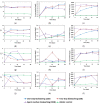Interesting Halophilic Sulphur-Oxidising Bacteria with Bioleaching Potential: Implications for Pollutant Mobilisation from Mine Waste
- PMID: 36677514
- PMCID: PMC9866277
- DOI: 10.3390/microorganisms11010222
Interesting Halophilic Sulphur-Oxidising Bacteria with Bioleaching Potential: Implications for Pollutant Mobilisation from Mine Waste
Abstract
For many years, research on the microbial-dissolution of metals from ores or waste materials mainly focussed on the study of acidophilic organisms. However, most acidophilic bioleaching microorganisms have limited tolerance to high chloride concentrations, thereby requiring fresh water for bioleaching operations. There is a growing interest in the use of seawater for leaching purposes, especially in regions with less access to fresh water. Consequently, there is a need to find halophilic organisms with bioleaching potentials. This study investigated the bioleaching potentials of four moderately halophilic sulphur-oxidising bacteria: Thiomicrospira cyclica, Thiohalobacter thiocyanaticus, Thioclava electrotropha and Thioclava pacifica. Results revealed T. electrotropha and T. pacifica as the most promising for bioleaching. Pure cultures of the two Thioclava strains liberated about 30% Co, and between 8-17% Cu, Pb, Zn, K, Cd, and Mn from a mine waste rock sample from the Neves Corvo mine, Portugal. Microwave roasting of the waste rock at 400 and 500 °C improved the bioleaching efficiency of T. electrotropha for Pb (13.7 to 45.7%), Ag (5.3 to 36%) and In (0 to 27.4%). Mineralogical analysis of the bioleached residues using SEM/MLA-GXMAP showed no major difference in the mineral compositions before or after bioleaching by the Thioclava spp. Generally, the bioleaching rates of the Thioclava spp. are quite low compared to that of the conventional acidophilic bioleaching bacteria. Nevertheless, their ability to liberate potential pollutants (metal(loid)s) into solution from mine waste raises environmental concerns. This is due to their relevance in the biogeochemistry of mine waste dumps, as similar neutrophile halophilic sulphur-oxidising organisms (e.g., Halothiobacillus spp.) have been isolated from mine wastes. On the other hand, the use of competent halophilic microorganisms could be the future of bioleaching due to their high tolerance to Cl- ions and their potential to catalyse mineral dissolution in seawater media, instead of fresh water.
Keywords: Thioclava electrotropha; Thioclava pacifica; Thiohalobacter thiocyanaticus; Thiomicrospira cyclica; bioleaching; halophilic sulphur-oxidising bacteria; mine waste rock; pollutant mobilisation.
Conflict of interest statement
The authors declare no conflict of interest. The funders had no role in the design of the study; in the collection, analyses, or interpretation of data; in the writing of the manuscript; or in the decision to publish the results.
Figures







References
-
- Vriens B., Plante B., Seigneur N., Jamieson H. Mine Waste Rock: Insights for Sustainable Hydrogeochemical Management. Minerals. 2020;10:728. doi: 10.3390/min10090728. - DOI
-
- Amos R.T., Blowes D.W., Bailey B.L., Sego D.C., Smith L., Ritchie A.I.M. Waste-rock hydrogeology and geochemistry. Appl. Geochem. 2015;57:140–156. doi: 10.1016/j.apgeochem.2014.06.020. - DOI
-
- Falagán C., Grail B.M., Johnson D.B. New approaches for extracting and recovering metals from mine tailings. Miner. Eng. 2017;106:71–78. doi: 10.1016/j.mineng.2016.10.008. - DOI
Grants and funding
LinkOut - more resources
Full Text Sources
Molecular Biology Databases
Miscellaneous

